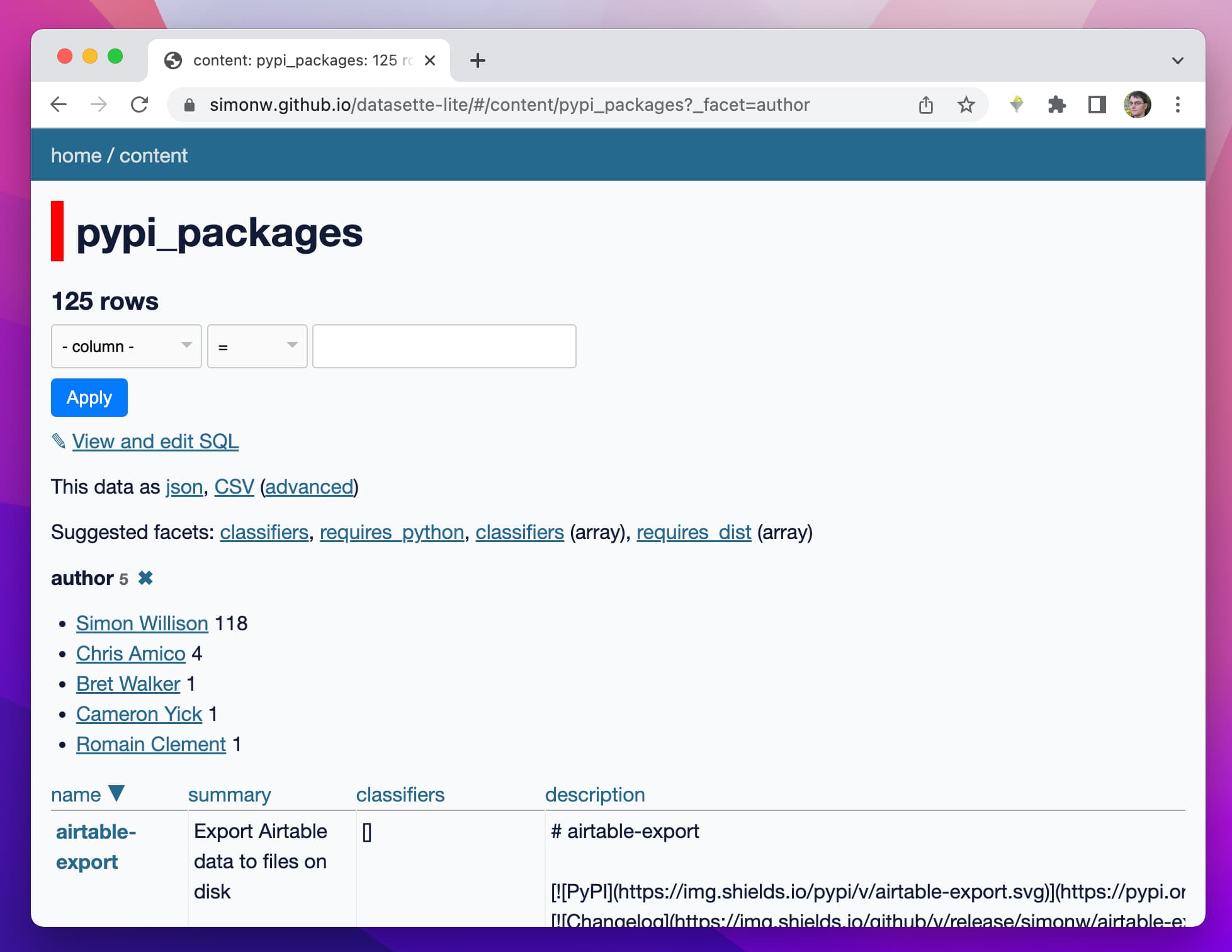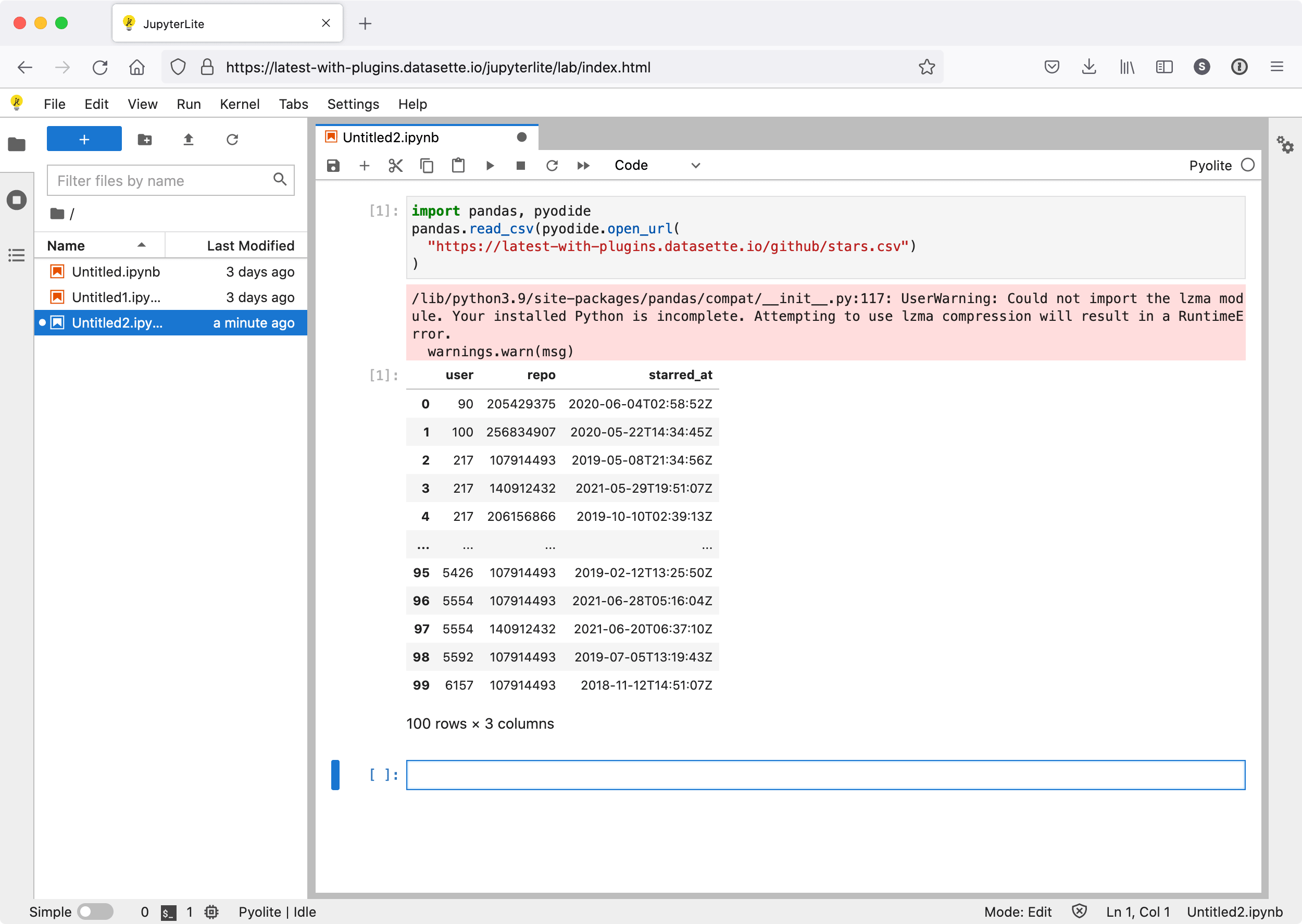83 posts tagged “webassembly”
2022
The State of WebAssembly 2022. Colin Eberhardt talks through the results of the State of WebAssembly 2022 survey. Rust continues to dominate as the most popular language for working to WebAssembly, but Python has a notable increase of interest.
Weeknotes: Datasette Lite, nogil Python, HYTRADBOI
My big project this week was Datasette Lite, a new way to run Datasette directly in a browser, powered by WebAssembly and Pyodide. I also continued my research into running SQL queries in parallel, described last week. Plus I spoke at HYTRADBOI.
[... 1,434 words]Datasette Lite: a server-side Python web application running in a browser
Datasette Lite is a new way to run Datasette: entirely in a browser, taking advantage of the incredible Pyodide project which provides Python compiled to WebAssembly plus a whole suite of useful extras.
[... 4,800 words]sqlite-utils 3.26.1 (via) I released sqlite-utils 3.36.1 with one tiny but exciting feature: I fixed its one dependency that wasn’t published as a pure Python wheel, which means it can now be used with Pyodide—Python compiled to WebAssembly running in your browser!
PyScript demos (via) PyScript was announced at PyCon this morning. It’s a new open source project that provides Web Components built on top of Pyodide, allowing you to use Python directly within your HTML pages in a way that is executed using a WebAssembly copy of Python running in your browser. These demos really help illustrate what it can do—it’s a fascinating new piece of the Python web ecosystem.
Mac OS 8 emulated in WebAssembly (via) Absolutely incredible project by Mihai Parparita. This is a full, working copy of Mac OS 8 (from 1997) running in your browser via WebAssembly—and it’s fully loaded with games and applications too. I played with Photoshop 3.0 and Civilization and there’s so much more on there to explore too—I finally get to try out HyperCard!
WebAssembly in my Browser Desktop Environment (via) Dustin Brett built the WebAssembly demo to end all WebAssembly demos: his daedalOS browser desktop environment simulates a Windows-style operating system, and bundles WebAssembly projects that include v86 for 486 emulation, js-dos for DOS emulation to run Doom, BoxedWine to run Wine applications like Notepad++, Ruffle to emulate Flash, ffmpeg.wasm to power audio and video conversion, WASM-ImageMagick for image conversion, Pyodide for a Python shell and more besides that!
webvm.io (via) This is one heck of a tech demo: it’s a full copy of Debian, compiled to WebAssembly and running in your browser. It’s fully stocked with Python, Perl, Ruby, Node.js and even a working gcc compiler! The underlying technology, CheerpX, is a closed-source WebAssembly virtualization platform.
SQLime: SQLite Playground (via) Anton Zhiyanov built this useful mobile-friendly online playground for trying things out it SQLite. It uses the sql.js library which compiles SQLite to WebAssembly, so it runs everything in the browser—but it also supports saving your work to Gists via the GitHub API. The JavaScript source code is fun to read: the site doesn’t use npm or Webpack or similar, opting instead to implement everything library-free using modern JavaScript modules and Web Components.
Announcing Parcel CSS: A new CSS parser, compiler, and minifier written in Rust! An interesting thing about tools like this being written in Rust is that since the Rust-to-WASM pipeline is well trodden at this point, the live demo that this announcement links to runs entirely in the browser.
2021
Weeknotes: datasette-jupyterlite, s3-credentials and a Python packaging talk
My big project this week was s3-credentials, described yesterday—but I also put together a fun expermiental Datasette plugin bundling JupyterLite and wrote up my PyGotham talk on Python packaging.
[... 476 words]DuckDB-Wasm: Efficient Analytical SQL in the Browser (via) First SQLite, now DuckDB: options for running database engines in the browser using WebAssembly keep on growing. DuckDB means browsers now have a fast, intuitive mechanism for querying Parquet files too. This also supports the same HTTP Range header trick as the SQLite demo from a while back, meaning it can query large databases loaded over HTTP without downloading the whole file.
Hosting SQLite databases on Github Pages (via) I've seen the trick of running SQLite compiled to WASM in the browser before, but here it comes with an incredibly clever bonus trick: it uses SQLite's page structure to fetch subsets of the database file via HTTP range requests, which means you can run indexed SQL queries against a 600MB database file while only fetching a few MBs of data over the wire. Absolutely brilliant. Tucked away at the end of the post is another neat trick: making the browser DOM available to SQLite as a virtual table, so you can query and update the DOM of the current page using SQL!
2020
How Shopify Uses WebAssembly Outside of the Browser (via) I’m fascinated by applications of WebAssembly outside the browser. As a Python programmer I’m excited to see native code libraries getting compiled to WASM in a way that lets me call them from Python code via a bridge, but the other interesting application is executing untrusted code in a sandbox.
Shopify are doing exactly that—they are building a kind-of plugin mechanism where partner code compiled to WASM runs inside their architecture using Fastly’s Lucet. The performance numbers are in the same ballpark as native code.
Also interesting: they’re recommending AssemblyScript, a TypeScript-style language designed to compile directly to WASM without needing any additional interpreter support, as required by dynamic languages such as JavaScript, Python or Ruby.
Internet Archive Software Library: Flash (via) A fantastic new initiative from the Internet Archive: they’re now archiving Flash (.swf) files and serving them for modern browsers using Ruffle, a Flash Player emulator written in Rust and compiled to WebAssembly. They are fully interactive and audio works too. Considering the enormous quantity of creative material released in Flash over the decades this helps fill a big hole in the Internet’s cultural memory.
AVIF has landed. AVIF support landed in Chrome 85 a few weeks ago. It’s a new lossy royalty-free image format derived from AV1 video and it’s really impressive—it can achieve similar results to JPEG using a quarter of the file size! Jake digs into AVIF in detail, providing lots of illustrative examples created using the Squoosh online compressor, which now supports AVIF encoding. Jake used the same WebAssembly encoder from Squoosh to decode AVIF images in a web worker so that the demos in his article would work even for browsers that don’t yet support AVIF natively.
2019
Calling C functions from BigQuery with web assembly (via) Google BigQuery lets you define custom SQL functions in JavaScript, and it turns out they expose the WebAssembly.instantiate family of APIs. Which means you can write your UDD in C or Rust, compile it to WebAssembly and run it as part of your query!
WebAssembly at eBay: A Real-World Use Case (via) eBay used WebAssembly to run a C++ barcode reading library inside a web worker, passing images from the camera in order to provide a barcode scanning interface as part of their mobile web “add listing” page (a feature that had already proved successful in their native mobile apps). This is a great write-up, with lots of detail about how they compiled the library. They ended up running three barcode solutions in parallel web workers—two using WebAssembly, one in pure JavaScript—because their testing showed that racing between three implementations greatly increased the chance of a match due to how the different libraries handled poor quality or out-of-focus images.
Terrarium by Fastly Labs. Fastly have been investing heavily in WebAssembly, which makes sense as it provides an excellent option for a sandboxed environment for executing server-side code at the edge of their CDN offering. Terrarium is their “playground for experimenting with edge-side WebAssembly”—it lets you write a program in Rust, C, TypeScript or Wat (WebAssembly text format), compile it to WebAssembly and deploy it to a URL with a single button-click. It’s just a demo for the moment so deployments only persist for 15 minutes, but it’s a fascinating sandbox to play around with.
How Zoom’s web client avoids using WebRTC (via) It turns out video conferencing app Zoom uses their own WebAssembly compiled video and audio codecs and transmits H264 over WebSockets.
Pyodide: Bringing the scientific Python stack to the browser (via) More fun with WebAssembly: Pyodide attempts (and mostly succeeds) to bring the full Python data stack to the browser: CPython, NumPy, Pandas, Scipy, and Matplotlib. Also includes interesting bridge tools for e.g. driving a canvas element from Python. Really interesting project from the Firefox Data Platform team.
Wasmer: a Python library for executing WebAssembly binaries. This is a really interesting new tool: “pip install wasmer” and now you can load code that has been compiled to WebAssembly and call those functions directly from Python. It’s built on top of the wasmer universal WebAssembly runtime, written over just the past year in Rust by a team lead by Syrus Akbary, the author of the Graphene GraphQL library for Python.
2018
Squoosh. This is by far the most useful example of web assembly I’ve seen so far: Squoosh is a progressive web app for image optimization (JPEG, PNG, GIF, SVG and more) which uses emscripten-compiled versions of best in breed image codec implementations to provide a browser interface for applying and previewing those optimizations.

